About 360 feet (110 meters) away from that sampling site is an outcrop that caught the science team’s eye because it contains igneous minerals crystallized from magma deep in the Martian crust. (Igneous rocks can form deep underground from magma or from volcanic activity at the surface, and they are excellent record-keepers — particularly because mineral crystals within them preserve details about the precise moment they formed.) But after two coring attempts (on Feb. 4 and Feb. 8) fizzled due to the rock being so crumbly, the rover drove about 520 feet (160 meters) northwest to another scientifically intriguing rock, dubbed “Tablelands.”
Data from the rover’s instruments indicates that Tablelands is made almost entirely of serpentine minerals, which form when large amounts of water react with iron- and magnesium-bearing minerals in igneous rock. During this process, called serpentinization, the rock’s original structure and mineralogy change, often causing it to expand and fracture. Byproducts of the process sometimes include hydrogen gas, which can lead to the generation of methane in the presence of carbon dioxide. On Earth, such rocks can support microbial communities.
Coring Tablelands went smoothly. But sealing it became an engineering challenge.
Flick Maneuver
“This happened once before, when there was enough powdered rock at the top of the tube that it interfered with getting a perfect seal,” said Kyle Kaplan, a robotics engineer at JPL. “For Tablelands, we pulled out all the stops. Over 13 sols,” or Martian days, “we used a tool to brush out the top of the tube 33 times and made eight sealing attempts. We even flicked it a second time.”
During a flick maneuver, the sample handling arm — a little robotic arm in the rover’s belly — presses the tube against a wall inside the rover, then pulls the tube away, causing it to vibrate. On March 2, the combination of flicks and brushings cleaned the tube’s top opening enough for Perseverance to seal and store the serpentine-laden rock sample.
Eight days later, the rover had no issues sealing its third rim sample, from a rock called “Main River.” The alternating bright and dark bands on the rock were like nothing the science team had seen before.
Up Next
Following the collection of the Main River sample, the rover has continued exploring Witch Hazel Hill, analyzing three more rocky outcrops (“Sally’s Cove,” “Dennis Pond,” and “Mount Pearl”). And the team isn’t done yet.
“The last four months have been a whirlwind for the science team, and we still feel that Witch Hazel Hill has more to tell us,” said Stack. “We’ll use all the rover data gathered recently to decide if and where to collect the next sample from the crater rim. Crater rims — you gotta love ’em.”
More About Perseverance
A key objective for Perseverance’s mission on Mars is astrobiology, including the search for signs of ancient microbial life. The rover is characterizing the planet’s geology and past climate, to help pave the way for human exploration of the Red Planet and is the first mission to collect and cache Martian rock and regolith.
NASA’s Mars Sample Return Program, in cooperation with ESA (European Space Agency), is designed to send spacecraft to Mars to collect these sealed samples from the surface and return them to Earth for in-depth analysis.
The Mars 2020 Perseverance mission is part of NASA’s Mars Exploration Program portfolio and the agency’s Moon to Mars exploration approach, which includes Artemis missions to the Moon that will help prepare for human exploration of the Red Planet.
NASA’s Jet Propulsion Laboratory, managed for the agency by Caltech in Pasadena, California, built and manages operations of the Perseverance rover.
Quelle: NASA
----
Update: 20.04.2025
.
NASA's Perseverance rover hits the Mars rock gold mine: 'It has been all we had hoped for and more'
"The last four months have been a whirlwind for the science team, and we still feel that Witch Hazel Hill has more to tell us."

One of Perseverance's hazard cameras captured the rover’s coring drill collecting the "Main River" rock sample on "Witch Hazel Hill" on March 10, 2025, the 1,441st Martian day, or sol, of the mission. (Image credit: NASA/JPL-Caltech)
NASA's Perseverance rover is reveling in a scientific bonanza on Mars after finding a diverse array of rocks that are providing eager scientists a glimpse into the planet's ancient history.
The Perseverance rover is currently exploring Mars hills, boulders and rocky outcrops along the rim of Jezero Crater, a dry, bowl-shaped depression north of the Martian equator that likely held a lake billions of years ago. Since reaching the crater's western rim in December of last year, the rover has focused its attention on the layered terrain of a tall slope called Witch Hazel Hill, which could hold clues to a period when Mars had a vastly different climate. In the past few months alone, the car-sized Perseverance has collected samples of five rocks, performed detailed analysis on seven others, and zapped an additional 83 with its laser for remote study — the robotic explorer's fastest pace of scientific data collection since it landed on the Red Planet four years ago, NASA says.
"During previous science campaigns in Jezero, it could take several months to find a rock that was significantly different from the last rock we sampled and scientifically unique enough for sampling," Katie Morgan, who is the Perseverance's project scientist at NASA's Jet Propulsion Laboratory in Southern California, said in a statement. "But up here on the crater rim, there are new and intriguing rocks everywhere the rover turns. It has been all we had hoped for and more."
The crater's western rim is proving to be a scientific goldmine because it contains lots of fragmented, once-molten rocks that had been blasted from deep beneath the surface billions of years ago by meteor impacts, possibly including the impact that created Jezero Crater itself, according to the statement.
Of key interest to astronomers is Perseverance's first crater rim sample, named Silver Mountain, which is a "one-of-a-kind treasure" likely dating back at least 3.9 billion years to the Noachian age — an early Martian period of heavy bombardment that shaped the planet's cratered landscape we see today, NASA recently said.
"My 26th sample, known as 'Silver Mountain,' has textures unlike anything we've seen before," the rover's official X account posted in February.
Not far away, the rover also found a rock rich in serpentine minerals, which typically form when water interacts with certain volcanic rocks. Scientists say this process can sometimes create hydrogen, a potential energy source for life as we know it here on Earth.
"The last four months have been a whirlwind for the science team, and we still feel that Witch Hazel Hill has more to tell us," said Morgan. "We'll use all the rover data gathered recently to decide if and where to collect the next sample from the crater rim."
"Crater rims — you gotta love 'em," she added.
Scientists are eager to return these and other samples Perseverance collected to Earth to determine whether there was ever life on the now-barren Mars. The fate of NASA's Mars Sample Return mission, however, continues to remain uncertain as the highly complex and technologically-challenging endeavor faces budget, schedule and engineering hurdles.
After cost projections soared to $11 billion and the sample return timeline stretched to no earlier than 2040, NASA began a complete overhaul of the plan and solicited new proposals from industry and academia to find a more affordable and faster way to return the samples to Earth. The agency's decision on the revised strategy isn't expected until mid-2026.
Quelle: SC
----
Update: 21.05.2025
.
NASA’s Perseverance Mars Rover to Take Bite Out of ‘Krokodillen’
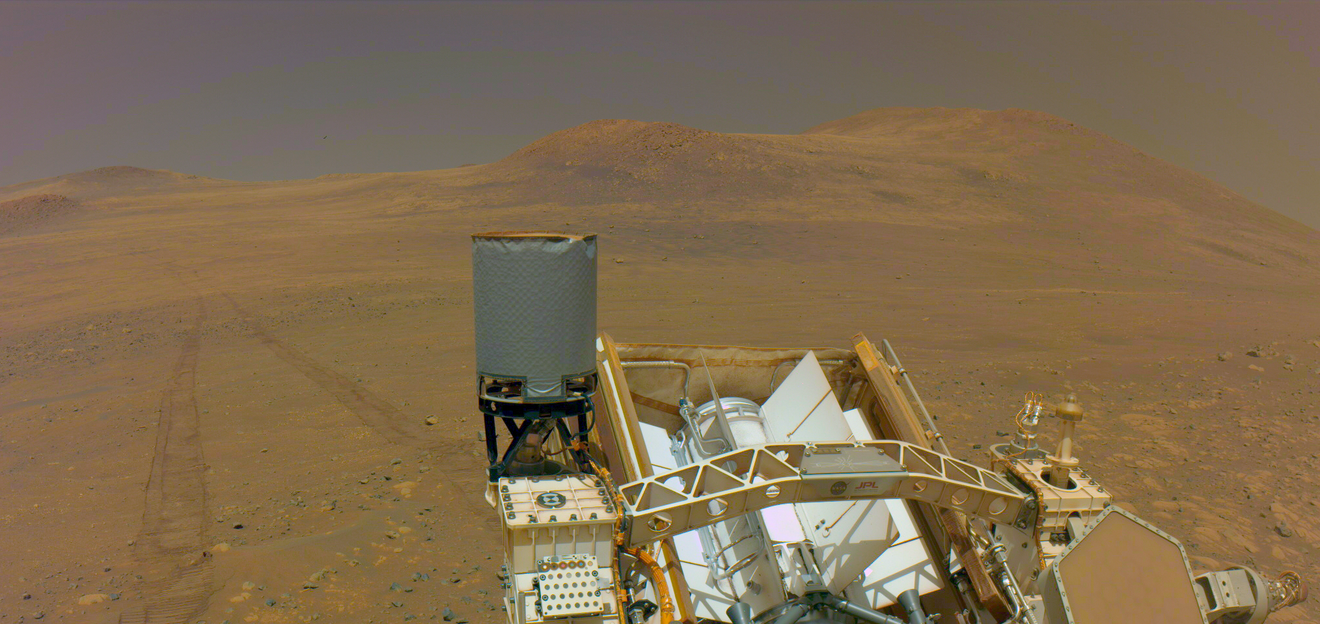
One of the navigation cameras on NASA’s Perseverance captured the rover’s tracks coming from an area called “Witch Hazel Hill,” on May 13, 2025, the 1,503rd Martian day, or sol, of the mission.
Credit: NASA/JPL-Caltech
Scientists expect the new area of interest on the lower slope of Jezero Crater’s rim to offer up some of the oldest rocks on the Red Planet.
NASA’s Perseverance Mars rover is exploring a new region of interest the team is calling “Krokodillen” that may contain some of the oldest rocks on Mars. The area has been on the Perseverance science team’s wish list because it marks an important boundary between the oldest rocks of Jezero Crater’s rim and those of the plains beyond the crater.
“The last five months have been a geologic whirlwind,” said Ken Farley, deputy project scientist for Perseverance from Caltech in Pasadena. “As successful as our exploration of “Witch Hazel Hill” has been, our investigation of Krokodillen promises to be just as compelling.”
Named by Perseverance mission scientists after a mountain ridge on the island of Prins Karls Forland, Norway, Krokodillen (which means “the crocodile” in Norwegian) is a 73-acre (about 30-hectare) plateau of rocky outcrops located downslope to the west and south of Witch Hazel Hill.
A quick earlier investigation into the region revealed the presence of clays in this ancient bedrock. Because clays require liquid water to form, they provide important clues about the environment and habitability of early Mars. The detection of clays elsewhere within the Krokodillen region would reinforce the idea that abundant liquid water was present sometime in the distant past, likely before Jezero Crater was formed by the impact of an asteroid. Clay minerals are also known on Earth for preserving organic compounds, the building blocks of life.
“If we find a potential biosignature here, it would most likely be from an entirely different and much earlier epoch of Mars evolution than the one we found last year in the crater with 'Cheyava Falls,'” said Farley, referring to a rock sampled in July 2024 with chemical signatures and structures that could have been formed by life long ago. “The Krokodillen rocks formed before Jezero Crater was created, during Mars’ earliest geologic period, the Noachian, and are among the oldest rocks on Mars
Data collected from NASA’s Mars orbiters suggest that the outer edges of Krokodillen may also have areas rich in olivine and carbonate. While olivine forms from magma, carbonate minerals on Earth typically form during a reaction in liquid water between rock and dissolved carbon dioxide. Carbonate minerals on Earth are known to be excellent preservers of fossilized ancient microbial life and recorders of ancient climate.
The rover, which celebrated its 1,500th day of surface operations on May 9, is currently analyzing a rocky outcrop in Krokodillen called “Copper Cove” that may contain Noachian rocks.
Ranking Mars Rocks
The rover’s arrival at Krokodillen comes with a new sampling strategy for the nuclear-powered rover that allows for leaving some cored samples unsealed in case the mission finds a more scientifically compelling geologic feature down the road.
To date, Perseverance has collected and sealed two regolith (crushed rock and dust) samples, three witness tubes, and one atmospheric sample. It has also collected 26 rock cores and sealed 25 of them. The rover’s one unsealed sample is its most recent, a rock core taken on April 28 that the team named “Bell Island,” which contains small round stones called spherules. If at some point the science team decides a new sample should take its place, the rover could be commanded to remove the tube from its bin in storage and dump the previous sample.
“We have been exploring Mars for over four years, and every single filled sample tube we have on board has its own unique and compelling story to tell,” said Perseverance acting project scientist Katie Stack Morgan of NASA’s Jet Propulsion Laboratory in Southern California. “There are seven empty sample tubes remaining and a lot of open road in front of us, so we’re going to keep a few tubes — including the one containing the Bell Island core — unsealed for now. This strategy allows us maximum flexibility as we continue our collection of diverse and compelling rock samples.”
Before the mission adopted its new strategy, the engineering sample team assessed whether leaving a tube unsealed could diminish the quality of a sample. The answer was no.
“The environment inside the rover met very strict standards for cleanliness when the rover was built. The tube is also oriented in such a way within its individual storage bin that the likelihood of extraneous material entering the tube during future activities, including sampling and drives, is very low,” said Stack Morgan.
In addition, the team assessed whether remnants of a sample that was dumped could “contaminate” a later sample. “Although there is a chance that any material remaining in the tube from the previous sample could come in contact with the outside of a new sample,” said Stack Morgan, “it is a very minor concern — and a worthwhile exchange for the opportunity to collect the best and most compelling samples when we find them.”
Quelle: NASA
----
Update: 23.05.2025
.
Devil’s in Details in Selfie Taken by NASA’s Mars Perseverance Rover
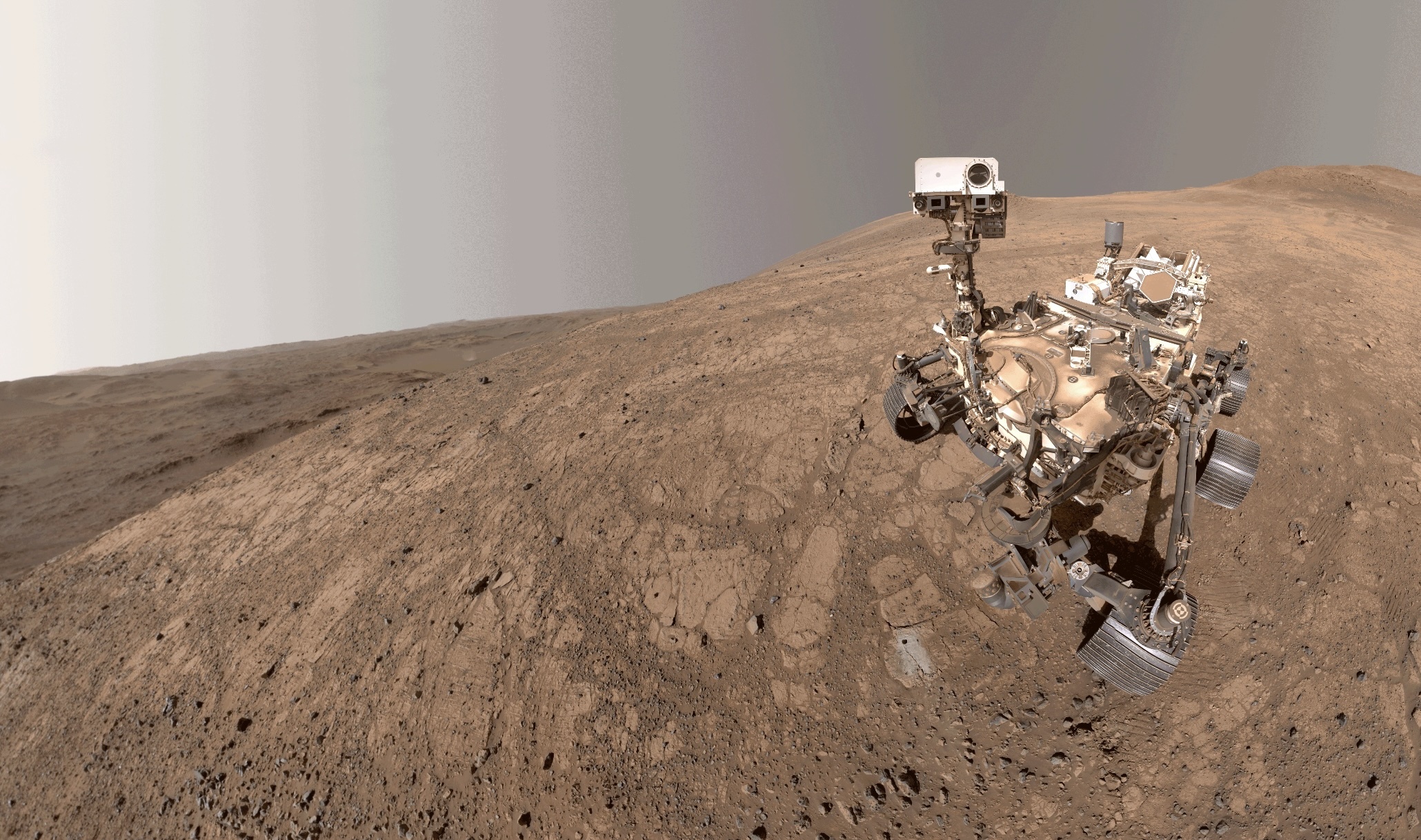
NASA’s Perseverance took this selfie on May 10, 2025. The small dark hole in the rock in front of the rover is the borehole made when Perseverance collected its latest sample. The small puff of dust left of center and below the horizon line is a dust devil.
Credit: NASA/JPL-Caltech/MSSS
The rover took the image — its fifth since landing in February 2021 — between stops investigating the Martian surface.
A Martian dust devil photobombed NASA’s Perseverance Mars rover as it took a selfie on May 10 to mark its 1,500th sol (Martian day) exploring the Red Planet. At the time, the six-wheeled rover was parked in an area nicknamed “Witch Hazel Hill,” an area on Jezero Crater’s rim that the rover has been exploring over the past five months.
“The rover self-portrait at the Witch Hazel Hill area gives us a great view of the terrain and the rover hardware,” said Justin Maki, Perseverance imaging lead at NASA’s Jet Propulsion Laboratory in Southern California, which manages the mission. “The well-illuminated scene and relatively clear atmosphere allowed us to capture a dust devil located 3 miles to the north in Neretva Vallis.”
The selfie also gives the engineering teams a chance to view and assess the state of the rover, its instruments, and the overall dust accumulation as Perseverance reached the 1,500-sol milestone. (A day on Mars is 24.6 hours, so 1,500 sols equals 1,541 Earth days.)
Fifty-nine individual images went into the creation of this Perseverance rover selfie.
Credit: NASA/JPL-Caltech/MSSS
The bright light illuminating the scene is courtesy of the high angle of the Sun at the time the images composing the selfie were taken, lighting up Perseverance’s deck and casting its shadow below and behind the chassis. Immediately in front of the rover is the “Bell Island” borehole, the latest sampling location in the Witch Hazel Hill area.
How Perseverance Did It
This newest selfie, Perseverance’s fifth since the mission began, was stitched together on Earth from a series of 59 images collected by the WATSON(Wide Angle Topographic Sensor for Operations and eNgineering) camera at the end of the robotic arm. It shows the rover’s remote sensing mast looking into the camera. To generate the version of the selfie with the mast looking at the borehole, WATSON took three additional images, concentrating on the reoriented mast.
A dust devil also whirled by in the distance as one of the hazard-avoidance cameras on NASA’s Perseverance captured the Mars rover coring a sample near the rim of Jezero Crater on April 29, 2025, the 1,490th Martian day, or sol, of the mission.
Credit: NASA/JPL-Caltech
“To get that selfie look, each WATSON image has to have its own unique field of view,” said Megan Wu, a Perseverance imaging scientist from Malin Space Science Systems in San Diego. “That means we had to make 62 precision movements of the robotic arm. The whole process takes about an hour, but it’s worth it. Having the dust devil in the background makes it a classic. This is a great shot.”
The dust covering the rover is visual evidence of the rover’s journey on Mars: By the time the image was captured, Perseverance had abraded and analyzed a total of 37 rocks and boulders with its science instruments, collected 26 rock cores (25 sealed and 1 left unsealed), and traveled more than 22 miles (36 kilometers).
“After 1,500 sols, we may be a bit dusty, but our beauty is more than skin deep,” said Art Thompson, Perseverance project manager at JPL. “Our multi-mission radioisotope thermoelectric generator is giving us all the power we need. All our systems and subsystems are in the green and clicking along, and our amazing instruments continue to provide data that will feed scientific discoveries for years to come.”
The rover is currently exploring along the western rim of Jezero Crater, at a location the science team calls “Krokodillen.”
Quelle: NASA
----
Update: 31.05.2025
.
A Dust Devil Photobombs Perseverance!
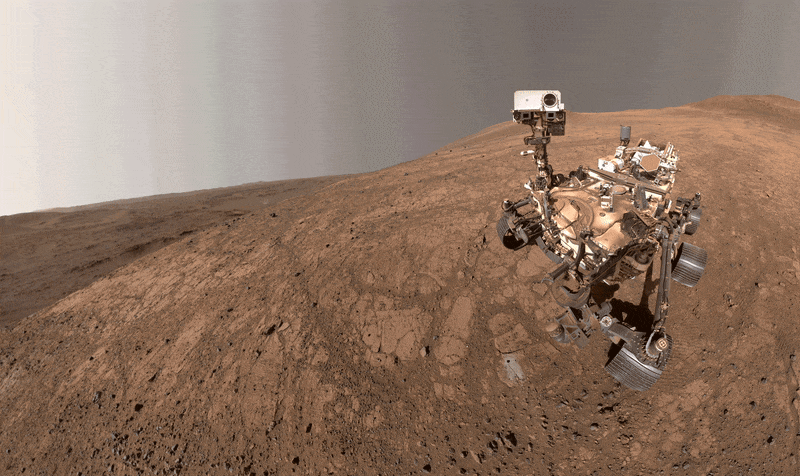
Perseverance self portrait, acquired by the WATSON camera on Sol 1500 on Mars. The Bell Island borehole where the rover acquired a sample is visible in the workspace in front of the rover.
NASA/JPL-Caltech/MSSS
Written by Athanasios Klidaras, Ph.D. candidate at Purdue University, and Megan Kennedy Wu, Senior Mission Operations Specialist at Malin Space Science Systems
To celebrate her 1,500th Martian day (“Sol”) exploring the red planet, the Perseverance rover used its robotic arm to take a selfie of the rover and the surrounding landscape. But when team members reviewed the photo, they were surprised to find that Perseverance had been photobombed!
As the rover sat at the “Pine Pond” workspace, located on the outer rim of Jezero crater, which it has been exploring for the past several months, the Wide Angle Topographic Sensor for Operations and eNgineering (WATSON) camera on the end of its arm was used to acquire a 59-image mosaic of the rover. This is the fifth “selfie” that Perseverance has acquired since landing on Mars in 2021. The rover’s robotic arm is not visible in the self portrait because — just like a selfie you would take with your own cellphone camera — rover operators make sure not to have the arm get “in the way” of the body of the rover. This is even easier to do on Mars because Perseverance needs to take 59 different images at slightly different arm positions to build up the selfie, and the elbow of the robotic arm is kept out of the way while the images are acquired. You can find more details about the Sol 1500 selfie here, and this YouTube video shows how the rover arm moves when these activities take place.
While snapping away, Perseverance was photobombed by a dust devil in the distance! These are relatively common phenomena both on Mars and in Earth’s desert regions, and form from rising and rotating columns of warm air, which gives the appearance of a dust tornado. Just like many other weather patterns, there is a peak “season” for dust-devil activity, and Jezero crater is in the peak of that season now (late northern spring). The one seen in the selfie is fairly large, about 100 meters, or 328 feet, across. While Perseverance regularly monitors the horizon for dust-devil activity with Navcam movies, this is the first time the WATSON camera on the end of the robotic arm has ever captured an image of a dust devil!
The dark hole in front of the rover, surrounded by gray rock powder created during the drilling process, shows the location of Perseverance’s 26th sample. Nicknamed “Bell Island” after an island near Newfoundland, Canada, this rock sample contains small spherules, thought to have formed by volcanic eruptions or impacts early in Martian history. Later, this ancient rock was uplifted during the impact that formed Jezero crater. Now that the rover has successfully acquired the spherule sample the science team was searching for, Perseverance is leaving the area to explore new rock exposures. Last week, the rover arrived at an exposure of light-toned bedrock called “Copper Cove,” and the science team was interested to determine if this unit underlies or overlies the rock sequence explored earlier. After performing an abrasion to get a closer look at the chemistry and textures, the rover drove south to scout out more sites along the outer edge of the Jezero crater rim.
Quelle: NASA
----
Update: 7.06.2025
.
Why does NASA's Perseverance rover keep taking pictures of this maze on Mars?
"SHERLOC is all about solving puzzles, and what better puzzle than a maze!"
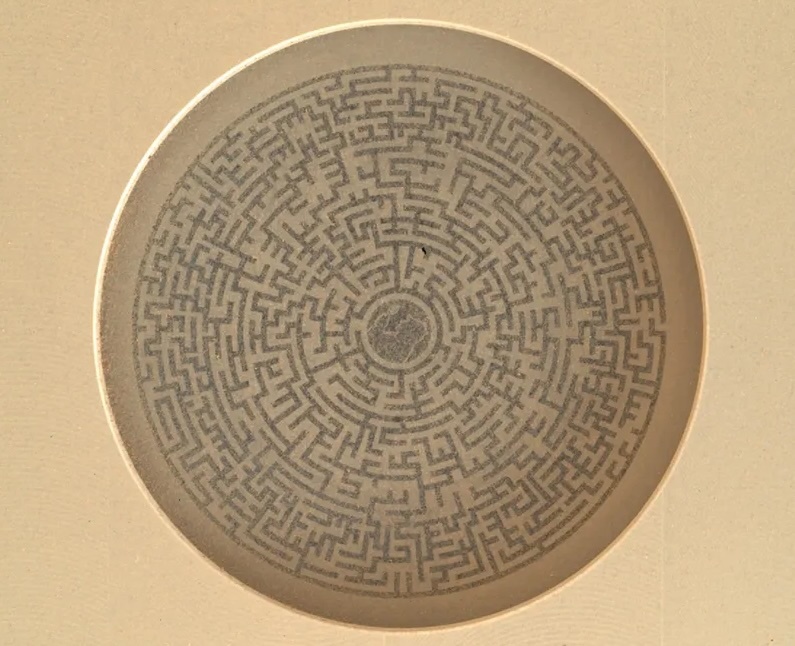
The SHERLOC Calibration Target on NASA's Perseverance Mars rover. (Image credit: NASA/JPL-Caltech)
If you've spent any time perusing the carousel of raw images from NASA's Perseverance Mars rover, you might have stumbled across an odd subject: a tiny, intricate maze etched into a small plate, photographed over and over again.
Why is the Perseverance rover so obsessed with this little labyrinth? It turns out the maze is a calibration target — one of 10 for Perseverance's Scanning Habitable Environments with Raman & Luminescence for Organics and Chemicals instrument, otherwise known for its fun acronym, SHERLOC.
This Sherlock Holmes–inspired tool is designed to detect organic compounds and other minerals on Mars that could indicate signs of ancient microbial life. To do that accurately, the system must be carefully calibrated, and that's where the maze comes in.
Located on the rover's seven-foot (2.1-meter) robotic arm, SHERLOC uses spectroscopic techniques — specifically Raman and fluorescence spectroscopy — to analyze Martian rocks. In order to ensure accurate measurements, it must routinely calibrate its tools using a set of reference materials with specific properties. These are mounted on a plate attached to the front of the rover's body: the SHERLOC Calibration Target.
"The calibration targets serve multiple purposes, which primarily include refining the SHERLOC wavelength calibration, calibrating the SHERLOC laser scanner mirror, and monitoring the focus and state of health of the laser," Kyle Uckert, deputy principal investigator for SHERLOC at NASA's Jet Propulsion Laboratory, tells Space.com
The target is arranged in two rows, each populated with small patches of carefully selected materials.
The top row includes three critical calibration materials: aluminum gallium nitride (AlGaN) on sapphire discs; the UV-scattering material Diffusil; and Martian meteorite SaU008, whose mineral makeup is already known and helps align wavelength calibration with real Martian geology.
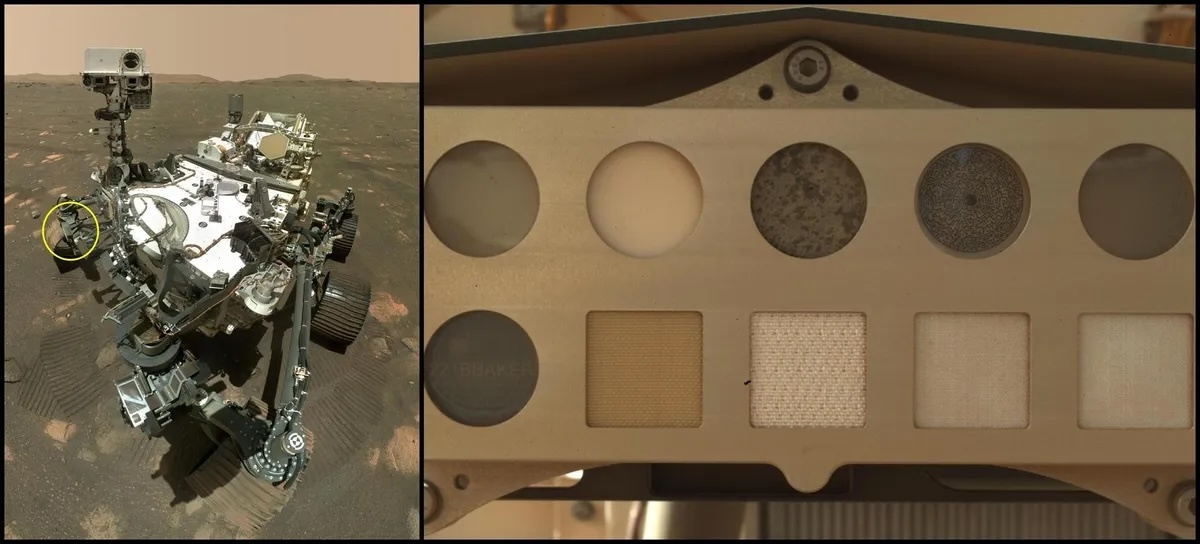
A Perseverance rover "selfie" showing the location of the SHERLOC Calibration Target. Right: An image of the full SHERLOC Calibration Target. (Image credit: NASA/JPL-Caltech/MSSS)
This is also where you'll find the maze. Why a maze? "SHERLOC is all about solving puzzles, and what better puzzle than a maze!" says Uckert. The purpose of the maze target is to calibrate the positioning of the laser scanner mirror and characterize the laser's focus, which requires a target with sharply contrasting spectral responses. The maze serves this purpose well."
The maze is made of chrome-plated lines just 200 microns thick (about twice the width of a human hair) printed onto silica glass. "There are no repeating patterns and the spectrum of the chrome plating is distinct from the underlying silica glass," says Uckert. That makes it possible to measure the laser's focus and accuracy with extreme precision.
If you look closely at the maze, you'll also notice a Sherlock Holmes portrait right at the center. While it's a cheeky nod to the instrument's name, it serves a practical function. "SHERLOC spectral maps can resolve the 200 micron thick chrome plated lines and the 50 micron thick silhouette of Sherlock Holmes at the center of the maze," Uckert notes.
Like the portrait, the bottom half of the SHERLOC Calibration Target also serves a dual purpose: spectral instrument calibration and spacesuit material testing. It contains five samples of materials used in modern spacesuits, including some materials you might be familiar with, like Teflon, Gore-Tex, and Kevlar. And don't miss the "fun" target in this row — there's a geocache marker backing a polycarbonate target, and it does indeed have a tie-in to Sherlock Holmes.
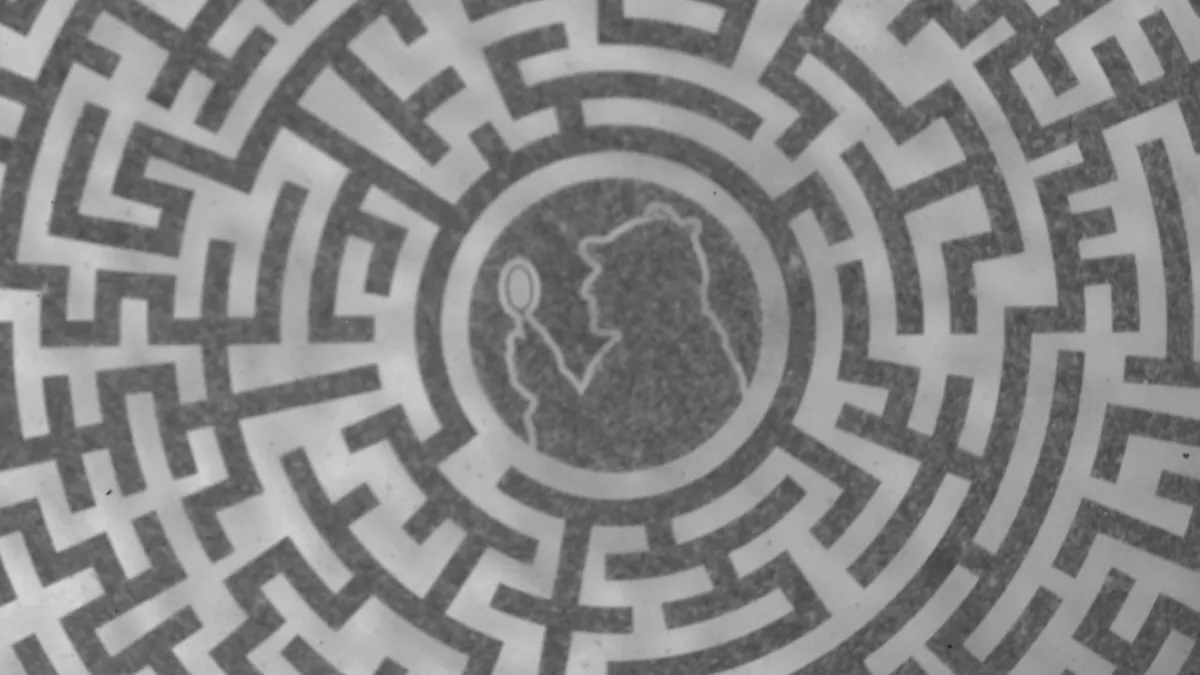
A close-up of the maze on the Perseverance rover's SHERLOC Calibration Target. (Image credit: NASA/JPL-Caltech
These materials are actively being tested under Mars conditions to determine how they hold up over time in situ, which is crucial for planning human exploration of the Red Planet. "Note that we use all of these materials to fine-tune SHERLOC," adds Uckert. "As a bonus, the spacesuit materials support unique science that will help keep future astronauts safe."
Now, if all these Sherlock Holmes–related Easter eggs on the SHERLOC Calibration Target aren't enough for you, there's one final link. SHERLOC has a color camera as part of its instrumentation suite that sometimes images the target, and it's called the Wide Angle Topographic Sensor for Operations and eNgineering.
Yes, SHERLOC's sidekick is called WATSON.
Quelle: SC
----
Update: 5.07.2025
.
Old Glory on the Red Planet
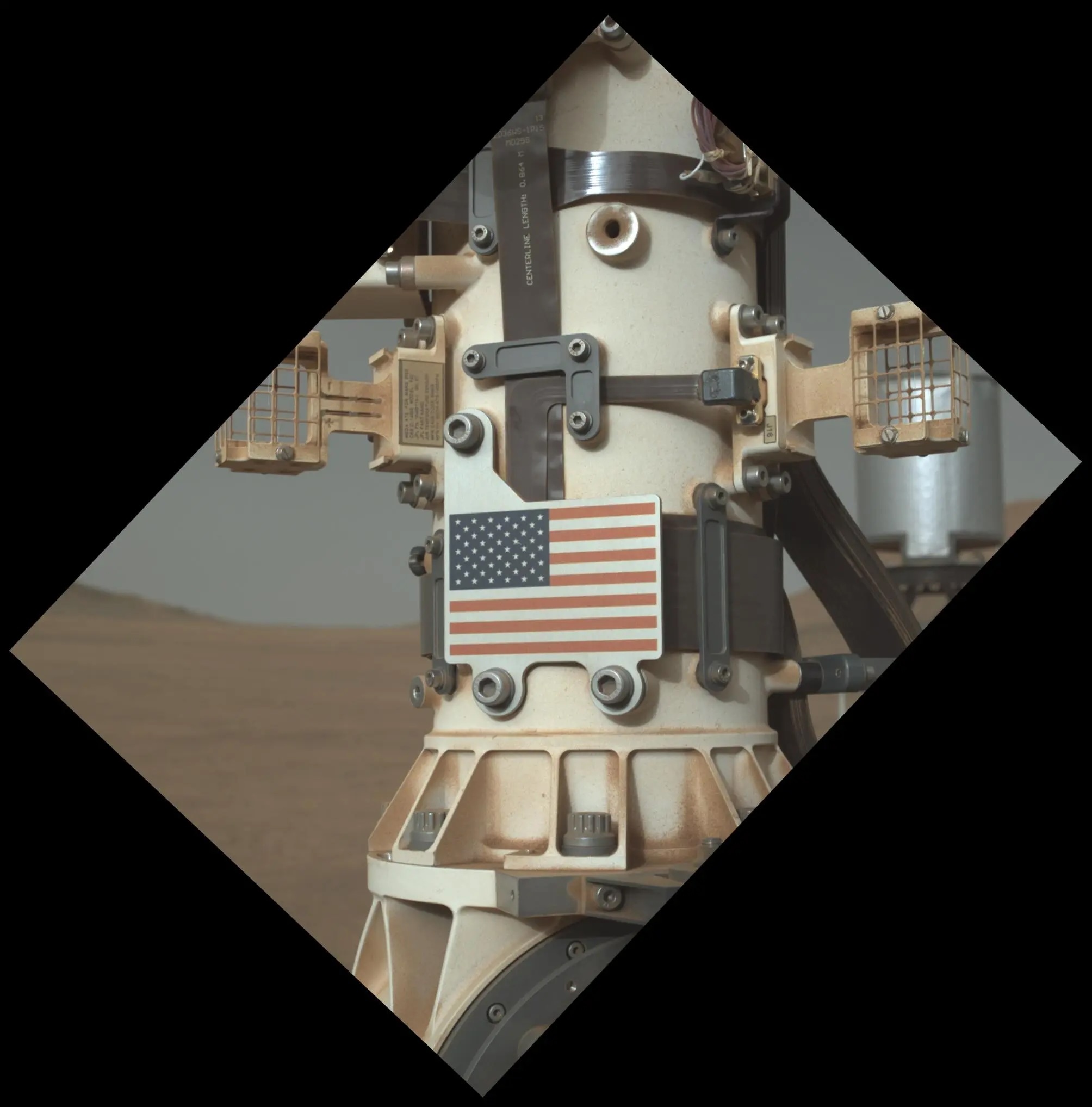
NASA/JPL-Caltech/MSSS
The United States flag adorns an aluminum plate mounted at the base of the mast, or “head,” of NASA’s Perseverance Mars rover. This image of the plate was taken on June 28, 2025 (the 1,548th day, or sol, of the mission), by the WATSON (Wide Angle Topographic Sensor for Operations and eNgineering) camera on the end of the rover’s robotic arm.
WATSON, part of an instrument called SHERLOC (Scanning Habitable Environments with Raman & Luminescence for Organics & Chemicals), was built by Malin Space Science Systems (MSSS) in San Diego and is operated jointly by MSSS and NASA’s Jet Propulsion Laboratory in Southern California. JPL, which is managed for the agency by Caltech, built and manages operations of the Perseverance rover.
Quelle: NASA
----
Update: 8.08.2025
.
NASA’s Perseverance Rover Captures Mars Vista As Clear As Day
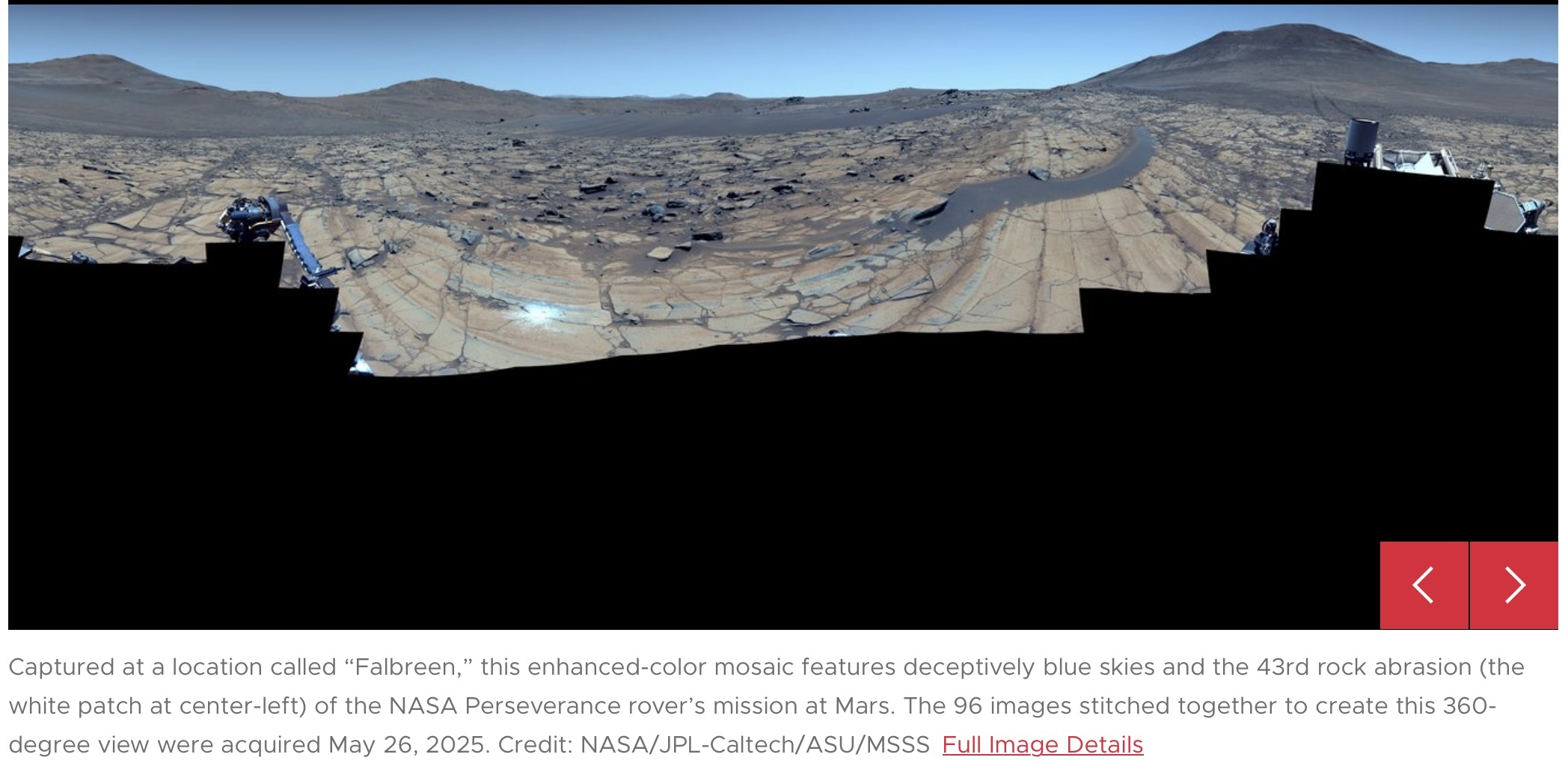
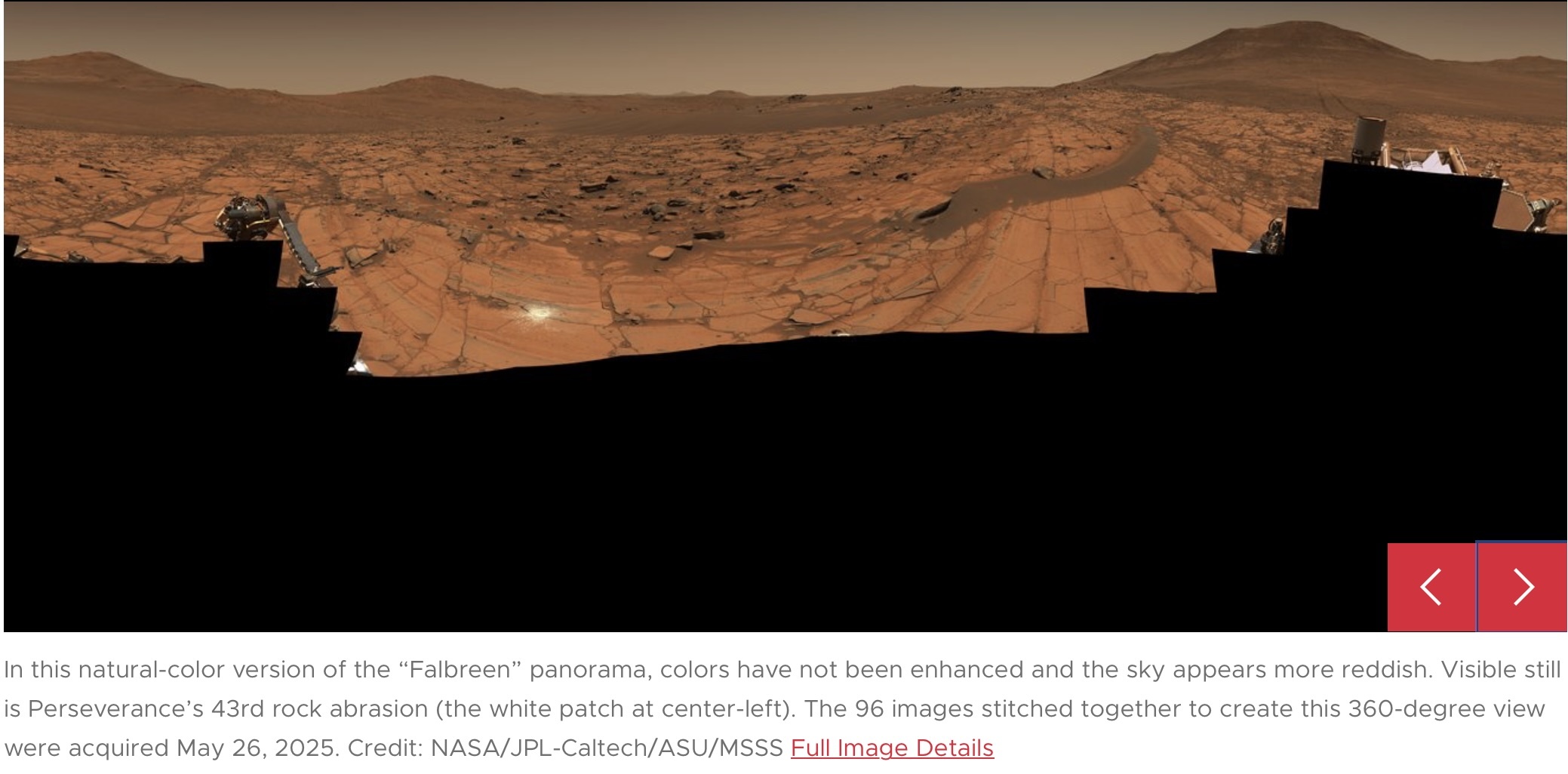
‘Float rocks,’ sand ripples, and vast distances are among the sights to see in the latest high-resolution panorama by the six-wheeled scientist.
The imaging team of NASA’s Perseverance Mars rover took advantage of clear skies on the Red Planet to capture one of the sharpest panoramas of its mission so far. Visible in the mosaic, which was stitched together from 96 images taken at a location the science team calls “Falbreen,” are a rock that appears to lie on top of a sand ripple, a boundary line between two geologic units, and hills as distant as 40 miles (65 kilometers) away. The enhanced-color version shows the Martian sky to be remarkably clear and deceptively blue, while in the natural-color version, it’s reddish.
“Our bold push for human space exploration will send astronauts back to the Moon,” said Sean Duffy, acting NASA administrator. “Stunning vistas like that of Falbreen, captured by our Perseverance rover, are just a glimpse of what we’ll soon witness with our own eyes. NASA’s groundbreaking missions, starting with Artemis, will propel our unstoppable journey to take human space exploration to the Martian surface. NASA is continuing to get bolder and stronger.”
The rover’s Mastcam-Z instrument captured the images on May 26, 2025, the 1,516th Martian day, or sol, of Perseverance’s mission, which began in February 2021 on the floor of Jezero Crater. Perseverance reached the top of the crater rim late last year.
“The relatively dust-free skies provide a clear view of the surrounding terrain,” said Jim Bell, Mastcam-Z’s principal investigator at Arizona State University in Tempe. “And in this particular mosaic, we have enhanced the color contrast, which accentuates the differences in the terrain and sky.”
Buoyant Boulder
One detail that caught the science team’s attention is a large rock that appears to sit atop a dark, crescent-shaped sand ripple to the right of the mosaic’s center, about 14 feet (4.4 meters) from the rover. Geologists call this type of rock a “float rock” because it was more than likely formed someplace else and transported to its current location. Whether this one arrived by a landslide, water, or wind is unknown, but the science team suspects it got here before the sand ripple formed.
The bright white circle just left of center and near the bottom of the image is an abrasion patch. This is the 43rd rock Perseverance has abraded since it landed on Mars. Two inches (5 centimeters) wide, the shallow patch is made with the rover’s drill and enables the science team to see what’s beneath the weathered, dusty surface of a rock before deciding to drill a core sample that would be stored in one of the mission’s titanium sample tubes.
The rover made this abrasion on May 22 and performed proximity science (a detailed analysis of Martian rocks and soil) with its arm-mounted instruments two days later. The science team wanted to learn about Falbreen because it’s situated within what may be some of the oldest terrain Perseverance has ever explored — perhaps even older than Jezero Crater.
Tracks from the rover’s journey to the location can be seen toward the mosaic’s right edge. About 300 feet (90 meters) away, they veer to the left, disappearing from sight at a previous geologic stop the science team calls “Kenmore.”
A little more than halfway up the mosaic, sweeping from one edge to the other, is the transition from lighter-toned to darker-toned rocks. This is the boundary line, or contact, between two geologic units. The flat, lighter-colored rocks nearer to the rover are rich in the mineral olivine, while the darker rocks farther away are believed to be much older clay-bearing rocks.
Quelle: NASA













